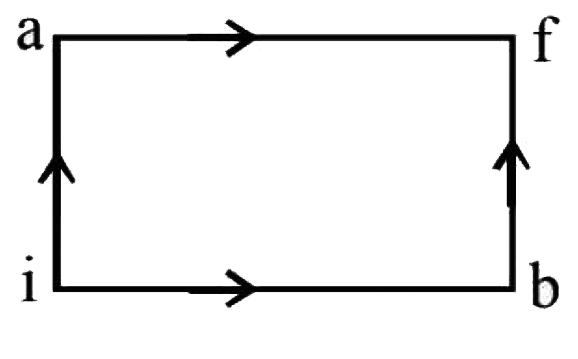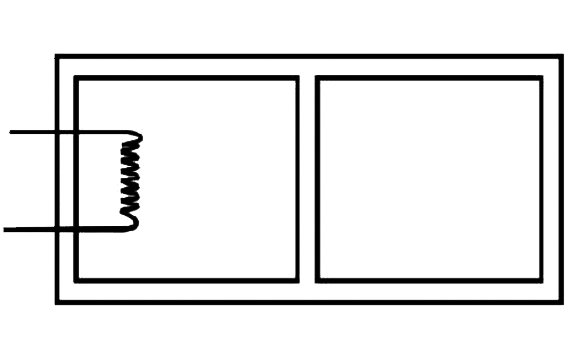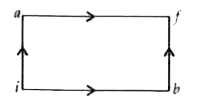When a system is taken from state i to state f along the path iaf, it is found that . Along the path ibf . W along the path ibf is
 Solution in Gujrati
Solution in Gujrati
cal
cal
cal
cal
The correct Answer is:A
As a thermodynamic system is taken from state to state f, then the internal energy of the system remains the same irrespective of the path followed cal
Topper's Solved these Questions
- GEOMETRICAL OPTICSBOOK - ALLEN CHAPTER - GEOMETRICAL OPTICSEXERCISE - EXERCISE - 05 (B)
58 Videos
- GEOMETRICAL OPTICSBOOK - ALLEN CHAPTER - GEOMETRICAL OPTICSEXERCISE - EXERCISE - 05 (B) (MCQ)
9 Videos
- GEOMETRICAL OPTICSBOOK - ALLEN CHAPTER - GEOMETRICAL OPTICSEXERCISE - EXERCISE - 04 (B)
15 Videos
- CURRENT ELECTRICITYBOOK - ALLEN CHAPTER - CURRENT ELECTRICITYEXERCISE - EX.II
66 Videos
- GRAVITATIONBOOK - ALLEN CHAPTER - GRAVITATIONEXERCISE - EXERCISE 4
9 Videos
Similar Questions
A vessel contains a mixture of one mole of oxygen and two moles of nitrogen at 300K. The ratio of the average rorational kinetic energy per O2 molecules to that per N2 molecules is
View SolutionLet ¯v,vrms and vp respectively denote the mean speed, the root-mean - square speed, and the most probable speed of the molecules in an ideal monoatomic gas at absolute temperature T. The mass of a molecule is m:-
View SolutionThe rectangular box shown in Fig has partition which can slide without friction along the length of the box. Initially each of the two chambers of the box has one mole of a mono-atomic ideal gas (λ=5/3) at a pressure P0, volume V0 and temperature T0. The chamber on the left is slowly heated by an electric heater. The walls of the box and the lead wires of the heater is negligible. The gas in the left chamber expands pushing the partition until the final pressure in both chambers becomes 243P0/32. Determine (i) the final temperature of the gas in each chamber and (ii) the work done by the gas in the right chamber.

View SolutionIn the Bohr's model of hy drogen atom, the electron moves around the nucleus in a circular orbit of radius 5×10−11m. Its time period is 1.5×10−16s. The current associated with the electron motion is:-
View SolutionAssertion : The difference in the value of acceleration due to gravity at pole and equator is proportional to square of angular velocity of earth.
Reason : the value of acceleration due to gravity is minimum at the equator and maximum at the pole.
View SolutionWhen a system is taken from state i to state f along the path iaf, it is found that Q=50 cal and W=20 cal . Along the path ibf Q=36cal . W along the path ibf is
View SolutionWhen a thermodynamic system is taken from an initial state I to a final state F along the path IAF, as shown in Fig. the heat energy absorbed by the system is Q=55J and work done by the system is W=25J. If the same system is taken along the path IBF, the value of Q=35J.
(a) If W=−15J for the curved path FI, how much heat energy is lost by the system along this path ?
(b) If U1=10J, what is UF ?
(d) If UB=20J, what is Q for the process BF and IB ?
View SolutionWhen a system is taken from state f along path iaf, Q = 50 J and W = 20 J . Along path ibf, Q = 35 J . If W = -13 J for the curved return path f I, Q for this path is
View SolutionWhen a system is taken from state i to state f alone the path iaf, it is found that Q=50 cal and W=20 cal. Along the path ibf, Q=36 cal (figure) (a) What is W along the path ibf ? (b) If W=-13 cal for the curved return path f i , what is Q for this path ? (c) Take U_(i)=10 cal. What is U_(f) ? (d) If U_(b)=22 cal, what is Q for the process in and for the process bf ?
View SolutionWhen a system is taken from a state i to a state f in Figure, along the path iaf , we find DeltaQ=50cal and DeltaW=20cal while during the path ibf , DeltaQ=36cal . If U_i=10cal . (a) What is U? What is W along the path ibf ? (c ) If W=-13cal , along the curved path fi , what is DeltaQ for this path? (d) If U_b=22cal , what is DeltaQ for the process ib ? for bf ?
View Solutionजब निकाय को चित्र में दर्शाये अनुसार अवस्था I से अवस्था f तक iaf मार्ग से ले जाया जाता है तो Q = 50 कैलोरी तथा W=20 कैलोरी है | यदि मार्ग ibf के लिए Q=36 कैलोरी हो तो ibf के लिए W का मान होगा -
View SolutionWhen a system is taken from state I to state f along path iaf in fig - 21.23 Q = 100 cal and W = 40 cal Along path ibf Q = 72 cal . (a) what is W along path ibf ?
View Solutionजब किसी निकाय के पथ iaf के अनुदिश चित्रानुसार अवस्था i से अवस्था f तक ले जाया जाता है तब Q=50 J तथा W = 20 J. एवं पथ ibf के अनुदिश Q= 35 J है। यदि f i पथ के अनुदिश वापस आने के लिये W= -13 J हो तो इस पथ के लिए Q है

View SolutionWhen a system is taken from state I to state f along the path iaf, it is found that Q = 50 cal and W = 20 cal. Along the path ibf, Q = 36 cal. W along the path ibf is

View SolutionWhen a system is taken from state i to a state f along path iaf, Q = 50 J and W = 20 J. Along path ibf, Q = 35 J. If W = -13 J for the curved return path f i, Q for this path is
View SolutionWhen a system is taken from state I to a state f along path iaf, Q=50J and W=20J. Along path fbi, Q=35J. If w=-13J for the return path fi, Q for this path is
View Solution
